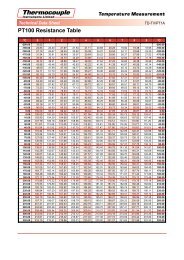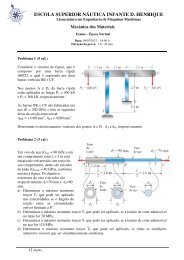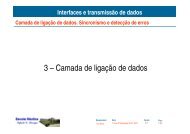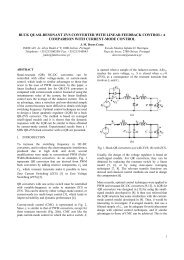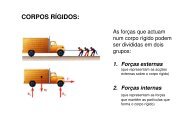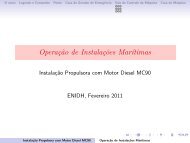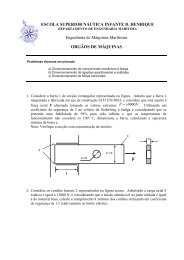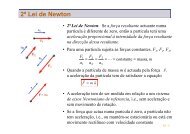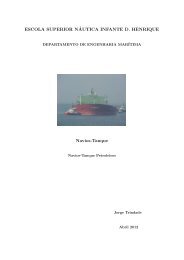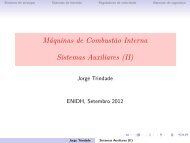Textos de Apoio (pdf)
Textos de Apoio (pdf)
Textos de Apoio (pdf)
Create successful ePaper yourself
Turn your PDF publications into a flip-book with our unique Google optimized e-Paper software.
Engine shaft power, % A<br />
110<br />
100<br />
90<br />
80<br />
70<br />
60<br />
50<br />
40<br />
A 100% reference point<br />
M Specified engine MCR<br />
O Optimising point<br />
mep<br />
110%<br />
100%<br />
90%<br />
80%<br />
70%<br />
60%<br />
A=M<br />
60 65 70 75 80 85 90 95 100 105<br />
(Logarithmic scales)<br />
Engine speed, % A<br />
O<br />
power will be nee<strong>de</strong>d but, of course,<br />
this will be higher for running in heavy<br />
weather with increased resistance on<br />
the ship.<br />
Direction of propeller rotation (si<strong>de</strong> thrust)<br />
When a ship is sailing, the propeller<br />
bla<strong>de</strong>s bite more in their lowermost position<br />
than in their uppermost position.<br />
The resulting si<strong>de</strong>-thrust effect is larger<br />
the more shallow the water is as, for<br />
example, during harbour manoeuvres.<br />
Therefore, a clockwise (looking from aft<br />
to fore) rotating propeller will tend to<br />
push the ship’s stern in the starboard<br />
direction, i.e. pushing the ship’s stem<br />
to port, during normal ahead running.<br />
This has to be counteracted by the<br />
rud<strong>de</strong>r.<br />
When reversing the propeller to astern<br />
running as, for example, when berthing<br />
alongsi<strong>de</strong> the quay, the si<strong>de</strong>-thrust effect<br />
is also reversed and becomes further<br />
pronounced as the ship’s speed<br />
<strong>de</strong>creases. Awareness of this behaviour<br />
is very important in critical situations<br />
and during harbour manoeuvres.<br />
Fig. 15: Load diagram – acceleration<br />
larger force than on the slow-going<br />
ship.<br />
4 Ships with a “flat” stem<br />
may be slowed down faster by waves<br />
than a ship with a “sharp” stem.<br />
Thus an axe-shaped upper bow may<br />
better cut the waves and thereby<br />
reduce the heavy running ten<strong>de</strong>ncy.<br />
5 Fouling of the hull and propeller<br />
will increase both hull resistance and<br />
propeller torque. Polishing the propeller<br />
(especially the tips) as often as<br />
possible (also when in water) has a<br />
positive effect. The use of effective<br />
anti-fouling paints will prevent fouling<br />
caused by living organisms.<br />
6 Ship acceleration<br />
will increase the propeller torque,<br />
and thus give a temporarily heavy<br />
running propeller.<br />
7 Sailing in shallow waters<br />
increases the hull resistance and reduces<br />
the ship’s directional stability.<br />
8 Ships with scewed propeller<br />
are able to absorb a higher torque<br />
un<strong>de</strong>r heavy running conditions.<br />
Manoeuvring speed<br />
Below a certain ship speed, called the<br />
manoeuvring speed, the manoeuvrability<br />
of the rud<strong>de</strong>r is insufficient because<br />
of a too low velocity of the water<br />
arriving at the rud<strong>de</strong>r. It is rather difficult<br />
to give an exact figure for an a<strong>de</strong>quate<br />
manoeuvring speed of the ship as the<br />
velocity of the water arriving at the rud<strong>de</strong>r<br />
<strong>de</strong>pends on the propeller’s slip<br />
stream.<br />
Often a manoeuvring speed of the<br />
magnitu<strong>de</strong> of 3.5-4.5 knots is mentioned.<br />
According to the propeller law,<br />
a correspondingly low propulsion<br />
According to Ref. [5], page 15-3, the<br />
real reason for the appearance of the<br />
si<strong>de</strong> thrust during reversing of the propeller<br />
is that the upper part of the propeller’s<br />
slip stream, which is rotative,<br />
strikes the aftbody of the ship.<br />
Thus, also the pilot has to know precisely<br />
how the ship reacts in a given<br />
situation. It is therefore an unwritten<br />
law that on a ship fitted with a fixed<br />
pitch propeller, the propeller is always<br />
<strong>de</strong>signed for clockwise rotation when<br />
sailing ahead. A direct coupled main<br />
engine, of course, will have the same<br />
rotation.<br />
In or<strong>de</strong>r to obtain the same si<strong>de</strong>-thrust<br />
effect, when reversing to astern, on<br />
ships fitted with a controllable pitch<br />
propeller, CP-propellers are <strong>de</strong>signed<br />
for anti-clockwise rotation when sailing<br />
ahead.<br />
19



![Conceitos transmissao de dados .Sinais[.pdf]](https://img.yumpu.com/50982145/1/190x146/conceitos-transmissao-de-dados-sinaispdf.jpg?quality=85)
![Packages e interfaces[.pdf]](https://img.yumpu.com/50629553/1/190x134/packages-e-interfacespdf.jpg?quality=85)
